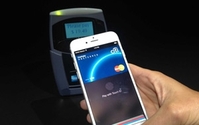 Since Apple launched its mobile payments service Apple Pay last week, various reports have come in about the customer experience based on early testing. But last night, Apple CEO Tim Cook attached a
number to the rollout, revealing that more than one million
credit cards were activated on Apple Pay in the first 72 hours.
Since Apple launched its mobile payments service Apple Pay last week, various reports have come in about the customer experience based on early testing. But last night, Apple CEO Tim Cook attached a
number to the rollout, revealing that more than one million
credit cards were activated on Apple Pay in the first 72 hours.
That suggests that adoption of Apple Pay is off to a solid start, especially considering that the service so far is
available only to iPhone 6 and iPhone 6 Plus owners. Apple has previously said more than 10 million of the new devices were sold over the first weekend of sales in September. But Cook’s crowing
might be premature.
advertisement
advertisement
For one thing, he pointed out a million-plus cards have activated on Apple Pay — not that it has a million users. Users can activate more than
one card through the service, so there could be fewer than a million people actually using it to date.
Furthermore, Apple Pay so far is only available at 220,000 retail locations in the U.S.,
or about 2% of the 12 to 15 million merchants that accept credit and debit cards. And at some of the stores where Apple Pay can be used — like Walgreens, Duane Reade and
Petco — one field test by Business Insider indicated that cashiers
weren’t aware that POS systems were Apple Pay-ready. Oops.
What’s more, as reported over the weekend, CVS and Rite-Aid have joined
retail giants including Walmart and Best Buy in blocking Apple Pay. The move by the drug chains is likely a result of their support of CurrentC from MCX — the merchant-backed payment platform
CurrentC works with consumers’ bank accounts and gift cards rather than with credit cards and doesn’t support the NFC technology behind Apple Pay.
That strategy to shout out Apple
Pay may ultimately backfire on the large retailers that are part of MCX, but for now it limits potential adoption of the service. “What matters most is not that people want to use it, it’s
where can you use it that’s the problem,” said Jeff Blyskal, a senior editor at Consumer Reports, which recently conducted its own of Apple Pay field test.
The test
— comparing the Apple platform with existing services including Google Wallet, the carrier-backed Softcard, and startup LoopPay — rated LoopPay as the
top offering and found that Apple Pay was only on par with the other two options. While Blyskal acknowledged that Apple rated best for ease of use — mainly because of the
TouchID button for authenticating purchases — LoopPay came out on top, partly because it can be used at 90% of retailers that accept plastic.
He also noted that Apple may benefit from
merchants upgrading their POS terminals in the next year to accept cards embedded with a chip. In the process of doing so, many will also include contactless readers and be able to handle NFC-based
payments. But even Apple’s renowned marketing powers won’t necessarily make mobile payments mainstream overnight.
“No one is going to choose a store based on whether it has
Apple Pay,” said Blyskal.